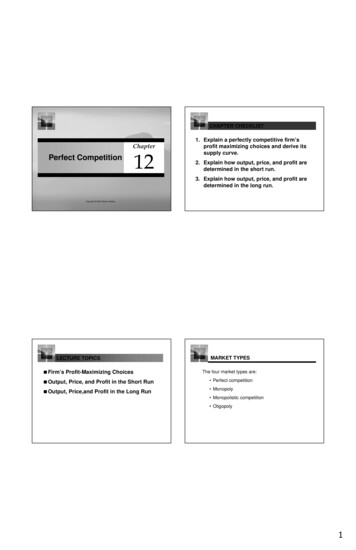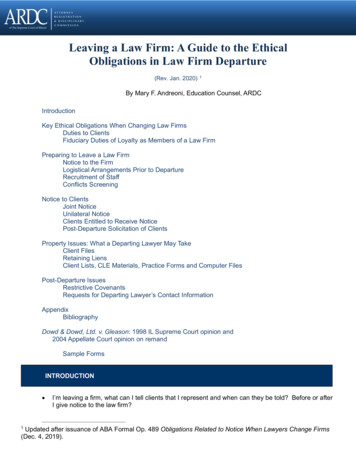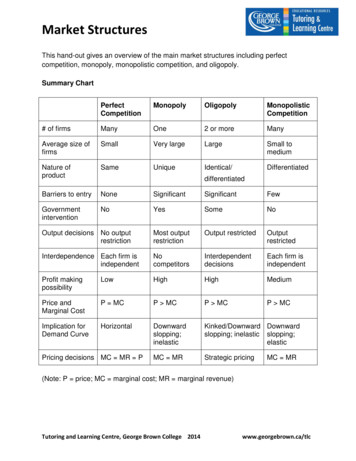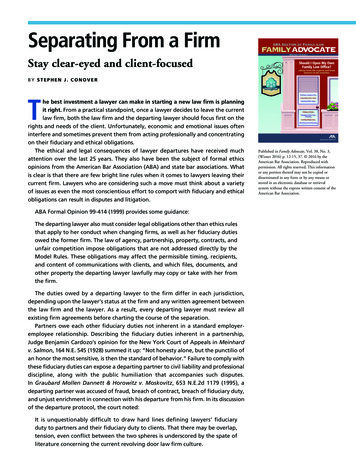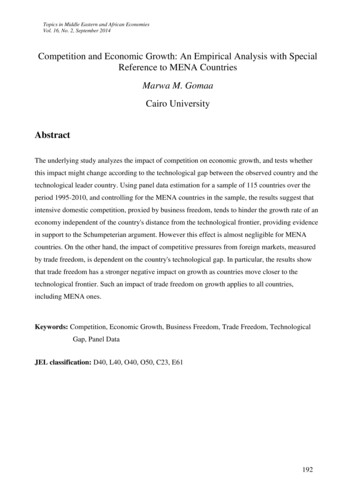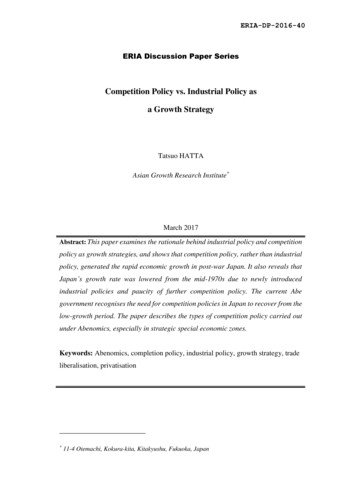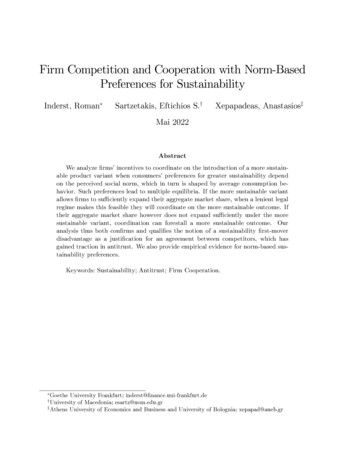
Transcription
Firm Competition and Cooperation with Norm-BasedPreferences for SustainabilityInderst, RomanSartzetakis, Eftichios S.yXepapadeas, AnastasioszMai 2022AbstractWe analyze rms’incentives to coordinate on the introduction of a more sustainable product variant when consumers’preferences for greater sustainability dependon the perceived social norm, which in turn is shaped by average consumption behavior. Such preferences lead to multiple equilibria. If the more sustainable variantallows rms to su ciently expand their aggregate market share, when a lenient legalregime makes this feasible they will coordinate on the more sustainable outcome. Iftheir aggregate market share however does not expand su ciently under the moresustainable variant, coordination can forestall a more sustainable outcome. Ouranalysis thus both con rms and quali es the notion of a sustainability rst-moverdisadvantage as a justi cation for an agreement between competitors, which hasgained traction in antitrust. We also provide empirical evidence for norm-based sustainability preferences.Keywords: Sustainability; Antitrust; Firm Cooperation.Goethe University Frankfurt; inderst@ nance.uni-frankfurt.deUniversity of Macedonia; esartz@uom.edu.grzAthens University of Economics and Business and University of Bolognia; xepapad@aueb.gry
1IntroductionIn March 2022 the European Commission published its draft horizontal guidelines onagreements between competitors.1 A key novelty is the inclusion of "sustainability agreements" as a new category. Also other jurisdictions have taken steps to recognize potentialsustainability bene ts when assessing horizontal agreements. For instance, also the Dutchcompetition authority has issued new guidelines,2 while Austria recognizes sustainabilitybene ts in its draft competition law reform.3 Testifying to the rapidly growing importanceof sustainability concerns in competition law enforcement also outside Europe, the OECDhas dedicated a roundtable to this topic in December 2021.4Recognizable e ciencies, including sustainability bene ts, must pass a test of indispensability. To this end, the new sustainability chapter in the Commission’s guidelinesexplicitly mentions a potential rst-mover disadvantage that would prevent rms fromrealizing the claimed sustainability bene ts individually. As the sharing of xed costs andinfrastructure investments already represent recognizable bene ts, e.g., in research anddevelopment agreements, prima facie it is not obvious what would be special with respectto sustainability agreements, so that rms have collectively but not individually su cientincentives to realize the respective bene ts.5 In this contribution we show how such a rst-mover disadvantage may materialize when consumers’sustainability preferences areshaped by social norms that in turn depend on the (anticipated) behaviour of others.While this may not be entirely speci c to sustainability preferences, social norms shouldbe particularly relevant in this case as preferences are not anchored by some immediateuse value and often have a moral dimension, such as altruism with respect to future generations.6 We provide additional empirical support for such preferences, using the data from1See European Commission (2022a) and the background in the respective expert report EuropeanCommission (2022b).2ACM (2021). Also the Hellenic authority has issued a statement of principles (HCC 2020).3According to this, contributions to an ecologically sustainable or climate-neutral economywill be considered alongside with consumer bene ts.See for the current draft in German: 4G 2021 nenforcement.htm.5We acknowledge that the internalization of out-of-market externalities, i.e., on non-consumers, isrelatively speci c to sustainability agreements. However, such bene ts are explicitly not recognized inthe draft horizontal guidelines. Moreover, one would need to ask why rms have collectively but notindividually incentives to internalize such externalities that can not be monetized in the market.6Non-use value refers to a valuation not based on actual, planned, or possible use by oneself (thoughpossibly by others); cf., Pearce et al. (2006). Such non-use values may still be anthropocentric, motivatedby altruism or bequest motives, or extend beyond this, such as in relation to animal welfare.2
a conjoint analysis conducted by the Dutch competition authority ("Chicken-of-Tomorrowcase"7 ; see below). Precisely, we show there that it is notably the willingness-to-pay for theless sustainable variant that decreases markedly when a consumer anticipates that only fewother consumers still choose this option. This is in line with our modelling assumptions ofconsumer preferences.We consider it of equal importance that with such preferences and the resulting network e ect, coordination between rms may however also lead to the less desirable, lesssustainable outcome. This is more likely when the considered rms cover most of the relevant market. We show that in this case also such preferences turn rms’product choicesinto strategic complements, albeit for di erent reasons. In particular, if rms choose different levels of sustainability, the responsiveness of demand increases, leading to increasedcompetition. Coordination then allows rms to avoid the more sustainable but jointly lesspro table outcome.8Our analysis, based on sustainability preferences shaped by social norms, thus bothcon rms and quali es a potential rst-mover disadvantage that would justify cooperationbetween competitors. The guidance derived from our formal analysis would call for cautionin particular when the involved rms cover much of the market and when they can notexpect a su cient expansion by introducing a more sustainable product variant. A casein place could be the coordination between German premium car manufacturers BMW,Daimler, and Volkswagen, covering also brands like Porsche or Audi, aimed at limitingthe development and roll-out of emission cleaning technologies for new diesel and petrolpassenger cars sold in the European Economic Area (EEA). At the time this case wasexamined, together these companies covered more than 80 % of the premium marketsegment in Europe.9 Also in terms of formal modelling, such an infringement may be moreadequately captured as coordination rather than collusion in an open-ended game (wherethe respective strategy is chosen repeatedly). In our model, coordination allows rms toselect among multiple equilibria, thereby either facilitating joint sustainable strategies orpreventing a more sustainable but jointly less pro table outcome.Generally, our assumption that individual preferences depend on social norms that areshaped by the behaviour of others is not novel also to economists. A well-known exam7For the decision see icken-of-Tomorrow-restrict-competition.8We note that such explicit coordination, even in the form of "cheap talk", would clearly be prohibited,that is unless it is treated as an admissible horizontal n/presscorner/detail/en/IP 19 2008).3
ple are experimental games of contributions to a public good. Sugden (1984) posits thatindividuals follow a conditional moral rule of "contributing of what I wish others to contribute, but not needing to contribute more than the person who contributes the least".10Such preferences have also been con rmed by various eld studies.11 In environmentaleconomics, Nyborg et al. (2006) invoke social norms, though without modelling marketinteractions. In this literature, in fact, "green preferences" are typically taken as exogenously given (e.g., Constantatos et al. 2019) or related to the maximum or minimum o eredlevel of sustainability. Thus, while rms have incentives to reduce competition throughdi erentiation,12 we show that with norm-based preferences for sustainability, di erentiation instead leads to more intense competition, so that rms’ sustainability strategiesbecome strategic complements. This again ties into the large literature on competitionwith network e ects. Farrell and Saloner (1985) recognize the potential bene ts fromcommunication to avoid coordination failure in the presence of network e ects, and thesubsequent Industrial Organization literature analyzes primarily competing networks (cf.Katz and Shapiro 1985 and notably in a Hotelling framework Griva and Vettas 2011). Aswe noted above, more generally network e ects can constitute appreciable bene ts whenassessing horizontal cooperations and they may arise from various sources, including theinvestment in joint infrastructure. In such a framework, Sartzetakis and Tsigaris (2005)analyze optimal environmental policies, such as taxation and subsidies.We organize our results as follows. Section 2 introduces the main ingredients of ourtheoretical analysis. Section 3 analyzes a baseline model. Section 4 extends the analysis.We conclude in Section 5. Proofs are collected in a separate Appendix, which containsalso the empirical part.2ModelTo introduce our key ideas, we keep the market environment as simple as possible. Themarket is populated by the mass one of consumers, each of which purchases (at most) asingle unit. We focus on a possible agreement by two rms, i A and B. Firms canproduce either a sustainable (s) or a non-sustainable (ns) variant of the product. The10Cf. more generally Benabou and Tirole (2006) on social norms. Imitation and conformism may alsogive rise to network e ects; cf. Grillo et al. (2001).11For instance, recycling behavior has been found to strongly correlate with beliefs about recyclingin the community (see the various studies quoted in Schultz 2002); for related experimental studies onenvironmental behavior see Alcott and Rogers (2014) or Jakob et al. (2017).12For this literature see, for instance, the references in Ambec and De Donder (2021).4
non-sustainable variant can be produced also by a market fringe. Firms’ o erings arehorizontally di erentiated, which allows them to earn a margin above costs. Originally,all rms o er the non-sustainable variant at marginal cost normalized to zero. The twostrategic rms can o er the sustainable variant after investing K0, with constant per-unit costs of production cs 0. K is speci c to each rm that switches to the sustainablevariant.13The model’s timing is as follows. We suppose that rms A and B choose rst whether too er the more or the less sustainable variant. Firms subsequently choose prices. Ultimatelyconsumers make their choices. We rst analyze the equilibria of this game. Subsequentlywe allow rms to possibly coordinate their sustainability investments. Throughout weask when rms will choose the sustainable variant. We thereby take it as given thatsocietal bene ts are highest when both rms choose the sustainable variant. This couldbe endogenized when production or consumption of the non-sustainable variant generatessu ciently high damages for society that are not internalized by consumers. We nextintroduce consumer preferences.Consumer Preferences. A consumer’s utility has four separable parts: an immediateuse value from the product u0 , with the sustainable variant providing an additional directvalue z; the price p; a base part that pertains to the social norm; and a part that pertainsto horizontal preferences between rms. To formalize the social norm, we denote by Sb aconsumer’s expectation of the fraction of purchases that are sustainable. Then consumersb while those purchasingpurchasing the sustainable variant receive additional value s S,the non-sustainable variant perceive a reduction equal tob Letting us be the utilityns S.from consuming the sustainable variant and uns that from the non-sustainable variant, wede neus u0 zuns u0p bpns SbsSd ;(1)d :The last part, d , captures horizontal preferences in a standard way, with d denoting thedistance of the rm’s o er to the consumer’s preferred variant. We next discuss in detailthe social-norm part, where we make the following key assumption:Assumption: Consumers share the same strictly positive social-norm preferences with: 13ns s 0:Otherwise, there is an immediate bene t from an agreement that allows to share such costs.5
All that matters in what follows is the size of , capturing ceteris paribus the e ectof the expected market share of the sustainable variant on the di erence between us anduns . Whenns 0, this captures a disutility that a consumer experiences from fallingbehind a perceived social (sustainability) norm, where we suppose that the perceived beb constitutes such a norm. When also s 0, a consumer’shavior of other consumers, S,willingness-to-pay for the sustainable variant increases when she anticipates that the re-spective contribution is shared by more consumers. In the Introduction we have discussedfoundations and evidence for the feedback e ect of other consumers’choices and the working of social norms. In what follows, we brie‡y introduce additional evidence that is moreclosely tied to the current setting. This con rms for the speci c circumstances of thepresented case not only that 0, but also that the negative feedback throughns 0can be particularly strong.Evidence from the "Chicken of Tomorrow" Case. In January 2015, the Netherland’s Authority for Consumers and Markets (ACM) decided on a planned agreementbetween producers, traders, and retailers aimed at introducing a minimum welfare standard for chicken ("Chicken of Tomorrow"). For this the ACM conducted a hypotheticalchoice experiment (conjoint analysis) with 1,603 panel members so as to thereby assessconsumers’willingness-to-pay. Ultimately, the ACM decided that the agreement did notqualify for the exemption from the cartel prohibition as consumers would not value theachieved sustainability improvement su ciently compared to the price increase that theparties wanted to impose jointly.14 The ACM shared these data with us for researchpurposes.In Appendix C we report results from a conditional logit analysis of these data. Importantly, next to the speci c sustainability attributes (outdoor access, living space, lifespan,and anaesthetized slaughtering), the choice options contained information on whether theparticular alternative was chosen either by a “large”or by a “small”number of consumers.In our analysis we both include this as an additional attribute and we examine its interaction with the various sustainability attributes. In terms of our previous notation, wecould thus conceive of two values Sb Sl or Sb Sh with Sl Sh , so that when Sb Sh ,the more sustainable variant is supposed to be chosen by a large number Sh and the lesssustainable by a small number Sl (and vice versa). Holding all else constant, when rstonly few consumers (Sl ) choose the sustainable variant but then more consumers (Sh ), this14See the Dutch case document Mulder et al (2014).6
increases the incremental willingness-to-pay, usuns , byS.In our empirical analysis, the inclusion of the interaction between the reported numberof consumers choosing the particular option and sustainability attributes allows us alsoto identify separately the two di erent components that make upandsS.(implyingOur key nding, leaving now out the multiplicant 0). In fact, it is in particular the partnsS,S,is thatthat isns nssS 0that is both economicallyimportant and statistically signi cant:15 Panelists’willingness-to-pay for a less sustainablevariant markedly decrease when this is supposedly no longer chosen by a large number ofconsumers.Horizontal Di erentiation. We turn next to horizontal di erentiation. We achievetractability by invoking an extended Hotelling model, which gives rise to linear demand.A key element of our comparative analysis is the extent to which the introduction of thesustainable variant allows rms to expand their (joint) market, rather than only shiftingmarket shares between them. To analyze this in a tractable way, we introduce threemarket segments: In market segment A the respective rm A competes with a fringe, rm B competes with a fringe in market segment B, and in market segment C rms Aand B compete against each other. The respective market sizes (mass of consumers) aredenoted by M for the market segment C, on which rms A and B compete, and, assumingsymmetry, by m for each of the two fringe market segments A and B, with 2m M 1.In terms of consumer preferences, in the two fringe markets consumers experience zerodi erentiation between the respective rm (A or B) and the fringe rms (so that di 0).Consumers in market segment C have horizontal preferences between the two rms thatare uniformly distributed over an interval of size one: A consumer with respective distanceparameter x derives disutility x when purchasing from A (thus dA x) and disutility(1x) when purchasing from B (thus dB 1x). In our baseline model, we allow rms A and B to set di erent prices in the respective market segments (pA and pB in therespective fringe market segments and pa and pb in segment C), which greatly simpli esthe analysis. In the subsequent section we show that results are robust when there isuniform pricing across all market segments.1615In our empirical analysis this holds for all separate interactions with the four sustainability attributesand thus not only when comparing the least with the most sustainable variant (where all four attributesare ‡ipped).16There, we also represent the three market segments as three intervals on a single Hotelling line oflength three, with rms A located at 1, rm B located at 2, and fringe market competitors located at 0and 3, respectively.7
To restrict attention to interior pricing solutions, we require that horizontal di erentiation in market C is su ciently important. To state the respective assumption we notethat, as is standard in a Hotelling context, the direct utility bene t of the sustainableproduct z a ects pro ts in the same way as the higher marginal costs cs , albeit with different sign. Capturing the net e ect of these two parameters by the variable v zcs ,we require that: 3 max(0; v 3):(2)AnalysisBefore we conduct the analysis for the case where consumers exhibit the hypothesizedsocial-norm preferences, as a benchmark it is informative to report on the outcome when 0.Benchmark ( 0): With standard preferences, there is generically a unique equilibrium in rms’ product choices, so that there is no scope for rms to coordinate theirstrategies.This observation stresses the importance of 0 for the subsequent analysis. Presently,we choose to report this result without a proof, which however will follow immediately,as a corner case, from the subsequent derivations (and, for ease of reference, is separatelytreated at the end of Appendix A). In what follows we will also return to this benchmarkwhen we discuss details of rms’pricing and product choice strategies.3.1Prices and Pro tsRecall that in our baseline model, rms can set separate prices in the market segments theyparticipate. These are now considered in turn, always taking as given rms’sustainabilitychoices. Recall also that in the fringe segments there is competition by at least one rm that is undi erentiated and sells the non-sustainable variant. We denote consumers’expectation of the fraction of market segment C that is served by rm A by (the thresholdtype) xbC .Lemma 1 (Prices on the Fringe Segments) When rm A o ers the nonsustainable variant, in the respective market segment A it can only set a price equal to costs (of zero),and this applies symmetrically to rm B. When both rms o er the sustainable variant,8
they both set pA pB z . When only rm A chooses the sustainable variant, itsprice in market segment A is pA z (m M xbC ), while when only rm B chooses thesustainable variant, its price is pB z (m M (1xbC )):When both rms o er the sustainable variant, in equilibrium all consumers will makea sustainable purchase, which for Sb 1 pushes up their willingness-to-pay by . Whenonly one rm o ers the sustainable variant, total market penetration depends on how themutually contested segment C is shared (and the relative importance of this segment, ascaptured by M ). The overall lower market penetration reduces consumers’ incrementalwillingness-to-pay for the more sustainable variant.Turning next to market segment C, we deal rst with the symmetric case, for whichwe can recoup the standard result that in a symmetric Hotelling setting prices are equalto marginal costs plus a margin equal to the di erentiation parameter, .Lemma 2 (Prices on the Contested Segment with Symmetric Product Choices) When both rms o er the nonsustainable variant, in market segment C they set the price pa pb .When both o er the sustainable variant, they set pa pb cs .We turn next to the asymmetric case, where we derive results in more detail. Supposefor speci city that only rm A introduces the sustainable variant. Now, using expressions(1), the o er of rm A yields to a consumer with preference parameter x the utilityb pb (1 x) , which, fromu0 s Sb pa x and that of rm B the utility u0ns Sindi erence, yields the threshold (when interior)xC zpa pb Sb.2(3)Importantly, in this expression Sb depends also on the expected cuto xbC : With asymmetric product choices and only rm A o ering the sustainable variant, Sb m M xbC .Substituting this into (3) and using, from rational expectations, that xbC xC , we have nallyxC z m p a pb.2M(4)This derivation makes transparent two e ects of the modi ed (norm-based) preferencesof consumers. If rm A reduces its price, this has both a direct e ect on the utility ofa consumer and an indirect e ect as it will expand overall purchases of the sustainableproduct and thus changes the norm and with it consumer preferences. This shows up in9
the (absolute value of the) slope of the cuto -type in (4): When the price pa is marginallydecreased, ceteris paribus, through a change in xC the marginal e ect on demand in themarket segment C (of size M ) is M (2M ) and thus strictly larger than withoutnorm-based preferences (or likewise in the symmetric case where both rms choose thesame alternative).17 Hence, when only one rm chooses the sustainable variant and 0, demand becomes more responsive to price changes, given the feedback e ect that achange in the market share has on consumers’preferences. This intensi es competition.Furthermore, again only for 0 there is an interaction between the two segments of themarket that rm A serves, A and C, which shows up in the term m in the numeratorof expression (4). As the mass m of consumers in market segment A choose also thesustainable variant, A’s product becomes more attractive to all consumers and pushes upxC . Solving for equilibrium prices, it is straightforward to obtain:Lemma 3 (Prices on the Contested Segment with Asymmetric Product Choices) Whenonly rm A chooses the sustainable variant, equilibrium prices in market segment C arepa pb 1[2cs z (m M )] ,31 [cs z 2 (m M )] .3 (5)This gives rise to the cuto type (A’s share of segment C)xC 3 z (m M )3 (2M)cs.(6)The case where only rm B chooses the sustainable variant is symmetric.We note that xC 1 holds if 318(2).(2M m) zWe brie‡y comment on the role ofcs , which is implied by assumption(as the dependency of prices and market shareson all other parameters is standard). The aforementioned increase in the responsiveness ofdemand to prices unambiguously reduces the price for the nonsustainable product. Whenmarket segment C is su ciently important with M m, also the price of the sustainableproduct decreases in . This follows again from the increased responsiveness of demand.However, when M m, instead, pa increases in. Then the immediate e ect of theincreased valuation for the sustainable product, which rm A captures by setting a higher17Note that our parameter assumptions imply that M 2 .While also xC 0 requires parameter restrictions, we suppress these as they are not required for theequilibrium characterization (where product variants are chosen optimally).1810
price, dominates. When 0, rm A has a larger share only when z cs . When however 0, the market share of A is still larger even when z cs , for 2(csz).We can next utilize these characterizations to determine pro ts for the di erent strategychoices. Given symmetry of the two fringe market segments, we can conveniently de nepro ts asns;sfor the case where the considered rm chooses the nonsustainable variantand the other rm the sustainable variant, and likewise for all other combinations. Thesepro ts are gross of investment costs K in case of choosing the sustainable variant. Summingup over all market segments and making use of the characterized equilibrium prices, fromLemmas 1 and 2 we obtain rst for the symmetric choices the following result:Lemma 4 (Pro ts for Symmetric Choices) Suppose both rms choose the same productvariant. If they choose the nonsustainable variant, their gross pro ts arethey choose the sustainable variant, their gross pro ts ares;sns;ns M 2 . If M 2 m( zcS ):From Lemma 4 we have immediately thats;sns;ns m( zcs ).Since, as in market segment C the higher utility of consumers is fully competed away, whenboth rms switch to the sustainable variant, they only make additional pro ts from marketsegments A and B, where they compete against the nonsustainable fringe (and only when z cs ). For competition on the fringe the fact that also the rival switches to thesustainable variant is bene cial, as the overall greater market penetration of sustainableproducts raises the social norm and with it the relative willingness-to-pay for the moresustainable product. Using next Lemma 3 and substituting into rms’pro t functions, wehave:Lemma 5 (Pro ts for Asymmetric Choices) Suppose only rm A o ers the sustainableproduct variant. Then rms’gross pro ts are given bys;ns m [ (m M xC ) zns;s M (1xC ) 1[cs3cs ] M x C 1[ (m3M) zcs ] ,(7)2 (m M )] ,zwith xC obtained from (6). When only rm B o ers the sustainable variant, expressionsare symmetric (with xC replaced by 1xC ).11
Fors;nsthe rst term in rectangular brackets in (7), multiplied by m, refers to thepro ts realized in the fringe market (of rm A), while the second term, multiplied by M ,refers to the contested market C. The rm choosing the non-sustainable variant only makespositive pro ts in market C, which is why there is only a single term inns;s(multipliedby M ). It is now instructive to brie‡y focus on rm A’s pro t from segment C. Moreover,we also suppose that M 1 and only for now that the sustainable product has no directadvantage or disadvantage as z cs . In this case rm A’s pro ts simplify tos;ns)2;)1 (3 9 (2which is strictly decreasing in .19 Recall now the two identi ed e ects thathas onpricing and pro ts. From the direct e ect, which pushes up the willingness-to-pay for thesustainable product relative to that of the non-sustainable product, rm A should gainwhen the norm e ect is stronger (higher ). But in the presently analyzed case (M 1,z cs ) this is more than compensated for by the increase in competition, which resultsfrom the increased responsiveness of demand. As we now add the fringe with m 0,intuitively the positive direct e ect becomes larger and the countervailing negative e ectthrough an increase in competition becomes smaller, where both changes follow from thesame logic: There is now a fraction of the market on which the two rms do not competedirectly but which a ects the overall penetration of the sustainable product and thus theshift in valuation due to the norm e ect. Indeed, we can show that, as a consequence,s;nsincreases inif and only if the fringe segments become su ciently important. Thisproperty will also feature in the subsequent discussion of equilibrium product choice.3.2Sustainability and CooperationIt is instructive to rst consider two corner cases, with either only market segment C(M 1) or only the two fringe market segments (M 0). This will allow us to isolate thekey economic forces, both for sustainable investments and for the scope of coordination.Subsequently, we analyze the interplay of these forces when we consider interior valuesof M . Throughout we focus on pure-strategy equilibria for product choice. At the coreof our analysis is a multiplicity of such equilibria over a wide range of parameter values.19In fact, we haved (3(2dwhich together with (2), securing)2) (3)((2 , is negative.12))2;
Coordination then allows rms to choose their jointly preferred outcome, and our maininterest lies in analyzing when this leads to less or to more sustainability.Competitive Choices when M 0. Take rst the corner case with M 0, so thatonly the fringe market segments exist. Recall now the notation v zcs , capturing thenet direct advantage (when positive) or disadvantage (when negative) of the sustainableproduct.Proposition 1 (Competitive Product Choices When M 0) When there is no contestedmarket segment C (M 0), equilibrium product choices are characterized as follows: There1 11000exist two cuto levels for the investment costs K, KM 0 2 ( 2 v) and KM 0 2 ( v),000so that for K KM 0 both rms choose the sustainable variant, for K KM 1 both rms0choose the nonsustainable variant, while for KM 0K00KM 0 there exists both anequilibrium where both rms choose the sustainable variant and one where no rm does so.When sustainability investment costs are low, it is immediate that both rms choosethe more sustainable variant, and likewise both rms choose the non-sustainable
Recognizable e ciencies, including sustainability bene-ts, must pass a test of indis-pensability. To this end, the new sustainability chapter in the Commission s guidelines explicitly mentions a potential -rst-mover disadvantage that would prevent -rms from realizing the claimed sustainability bene-ts individually.

